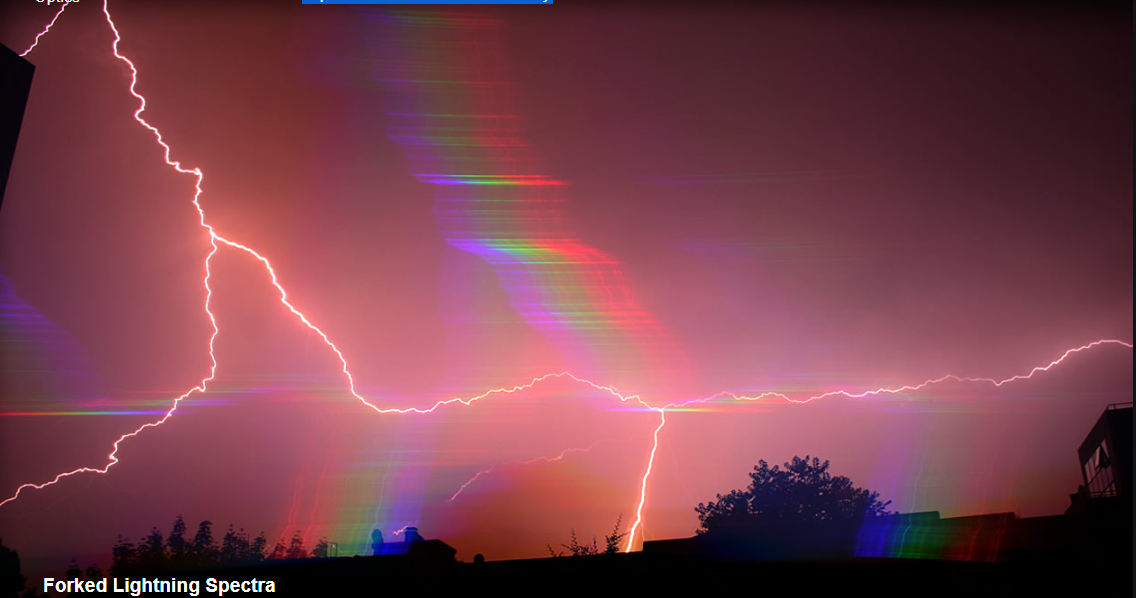OPOD - Hot Plasma - Lightning Spectra
OPOD - Hot Plasma - Lightning Spectra: Revealing the Mysteries of Lightning
Lightning is a mesmerizing natural phenomenon that captivates our attention and sparks our curiosity. It is a rapid series of electrical discharges that occur between the ground and a cloud or within clouds. While the exact mechanisms behind its formation are not fully understood, scientists have made significant progress in unraveling the mysteries of lightning. One intriguing aspect of lightning is the extreme conditions that exist within a lightning stroke, which can be unveiled through the analysis of lightning spectra.
Denis Joye, an avid photographer, captured stunning images of lightning spectra during a thunderstorm over Paris. By utilizing a 540 line/mm diffraction grating in front of his camera lens, Joye was able to reveal the intricate details of the lightning spectra. Typically, a slit is required to obtain clear line spectra, but the narrowness of the lightning strokes made it unnecessary in this case. The images showcase sharp emission lines from the spectrum superimposed on weaker continuum light, providing a glimpse into the extreme conditions inside a lightning stroke.
To comprehend the significance of lightning spectra, we must first grasp the intense energy involved in a lightning discharge. Currents of tens of thousands of amps surge through the atmosphere during a lightning strike. This immense current rapidly heats an air column that is only a few centimeters wide but can extend for several miles. The temperatures reached within a lightning stroke are staggering, ranging from 20,000 to 30,000 degrees Celsius. To put this into perspective, these temperatures are several times hotter than the surface of the sun.
Such extreme temperatures cause air molecules to dissociate into atoms and become ionized, resulting in the formation of a plasma. The lightning spectra captured by Joye highlight distinct lines from electronic transitions of nitrogen ions and hydrogen atoms. These spectra differ significantly from those observed in other atmospheric phenomena such as auroras and airglow, primarily due to variations in the excitation method and atmospheric pressure surrounding them.
The analysis of lightning spectra provides valuable insights into the physical processes occurring within a lightning stroke. By examining the emission lines, scientists can study the composition of the plasma and gain a deeper understanding of the chemical reactions taking place. This knowledge helps researchers improve lightning prediction models and enhance safety measures during thunderstorms.
It is important to approach lightning with utmost respect. While the allure of replicating Benjamin Franklin's legendary kite experiment may be enticing, it is crucial to remember the dangers associated with lightning. Numerous individuals who attempted to recreate Franklin's experiment found themselves facing perilous situations. Lightning is a force of nature that demands caution and awareness.
In conclusion, the study of lightning spectra offers a window into the extraordinary conditions within a lightning stroke. Denis Joye's remarkable images demonstrate the intricate details of lightning spectra, showcasing sharp emission lines and providing valuable insights into the nature of plasma formation. By further exploring these spectra, scientists can deepen their understanding of lightning and contribute to advancements in lightning prediction and safety. Let us continue to marvel at the wonders of lightning while respecting its immense power.

Forked Lightning Spectra
Denis Joye captured these lightning spectra during a thunderstorm over Paris. They reveal the extreme conditions inside a lightning stroke.
He used a 540 line/mm diffraction grating in front of the camera lens. A slit is usually needed to get good line spectra. Here the very narrow lightning strokes make a slit quite unnecessary. We see sharp spectrum emission lines superimposed on weaker continuum light. ©Denis Joye, shown with permission

Lightning is a rapid series of electrical discharges between the ground and a cloud or within clouds. The detailed mechanisms of its formation are not fully understood.
What we do know is that currents of tens of thousands of amps can be involved. The immense current rapidly heats an air column just a few cm wide and up to several miles long to temperatures of 20-30,000 Celsius, several times that of the sun’s surface. At these temperatures air molecules are dissociated into atoms and ionised to a plasma. The spectrum at right shows lines from electronic transitions of nitrogen ions and of hydrogen atoms.
These spectra are different from those of the aurora and airglow where the method of excitation and the surrounding atmospheric pressure are very dissimilar.
Respect lightning immensely. Several attempting to repeat Benjamin Franklin’s alleged kite experiment found it was the last bit of science they did.
Note: this article has been automatically converted from the old site and may not appear as intended. You can find the original article here.
Reference Atmospheric Optics
If you use any of the definitions, information, or data presented on Atmospheric Optics, please copy the link or reference below to properly credit us as the reference source. Thank you!
-
<a href="https://atoptics.co.uk/blog/opod-hot-plasma-lightning-spectra/">OPOD - Hot Plasma - Lightning Spectra</a>
-
"OPOD - Hot Plasma - Lightning Spectra". Atmospheric Optics. Accessed on April 16, 2024. https://atoptics.co.uk/blog/opod-hot-plasma-lightning-spectra/.
-
"OPOD - Hot Plasma - Lightning Spectra". Atmospheric Optics, https://atoptics.co.uk/blog/opod-hot-plasma-lightning-spectra/. Accessed 16 April, 2024
-
OPOD - Hot Plasma - Lightning Spectra. Atmospheric Optics. Retrieved from https://atoptics.co.uk/blog/opod-hot-plasma-lightning-spectra/.